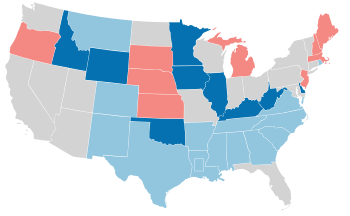| ||||||||||||||||||||||||||||||||||||||||
33 of the 96 seats in the United States Senate 49 seats needed for a majority | ||||||||||||||||||||||||||||||||||||||||
|---|---|---|---|---|---|---|---|---|---|---|---|---|---|---|---|---|---|---|---|---|---|---|---|---|---|---|---|---|---|---|---|---|---|---|---|---|---|---|---|---|
| ||||||||||||||||||||||||||||||||||||||||
 Results of the elections: Democratic gain Democratic hold Republican hold No election Rectangular inset (Louisiana): both seats up for election | ||||||||||||||||||||||||||||||||||||||||
| ||||||||||||||||||||||||||||||||||||||||
The 1948 United States Senate elections were held concurrently with the election of Democratic President Harry S. Truman for a full term. The 32 seats of Class 2 were contested in regular elections, and one special election was held to fill a vacancy. Truman campaigned against an "obstructionist" Congress that had blocked many of his initiatives, and additionally, the U.S. economy recovered from the postwar recession of 1946–1947 by election day. Thus, Truman was rewarded with a Democratic gain of nine seats in the Senate, enough to give them control of the chamber.[1][2] This was the last time until 2020 that Democrats flipped a chamber of Congress in a presidential election cycle.
- ^ William S. White (November 4, 1948). "SWEEP IN CONGRESS – Democrats Obtain 54-42 Margin in Senate by Winning 9 G.O.P. Seats". New York Times. Retrieved April 8, 2014.
- ^ "Truman Sweep". New York Times. November 7, 1948. Retrieved April 8, 2014.

